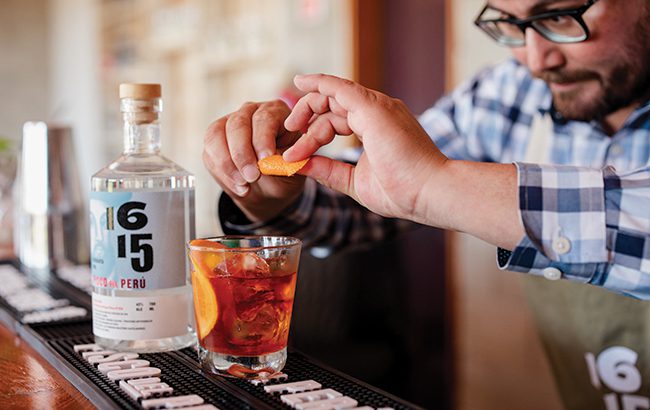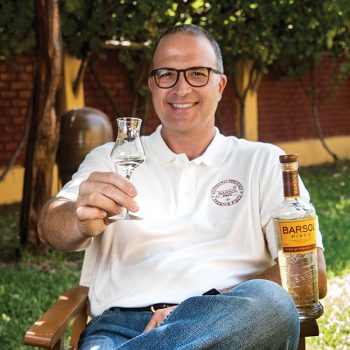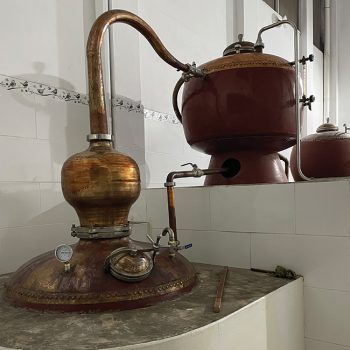Taking pisco into the mainstream
Outside of Peru, pisco is often considered a niche spirit. Bringing it to menus worldwide is a challenge the country’s producers are working on solving.

*This feature was originally published in the July 2024 issue of The Spirits Business magazine.
Pisco is Peru’s national spirit. The country has been making it for hundreds of years, dating back to when Spanish settlers arrived in the 16th century with wine grapes. It’s not exactly new. However, to the rest of the world, say the UK and Europe in particular, pisco remains a niche category.
The Pisco Sour has been pivotal in making it popular with consumers overseas, but with export volumes increasing year on year, Peru’s pisco producers are now looking to build an awareness that doesn’t revolve completely around its poster cocktail. There are more than 500 bodegas in Peru, and the country produces 7.7 million litres of the spirit a year – 40% of which is for export, according to data from PromPeru, the country’s official tourism board. Moreover, IWSR Drinks Market Analysis data reveals that neighbour Chile is its largest export market. But in 2023, more than 80% of Peruvian pisco was consumed in Peru. In this sense, it’s still very much a local spirit.
Juan Antonio Portugal, executive of agribusiness and fishery products for PromPeru’s export department, says pitching it abroad isn’t easy: “It’s a challenge to export, and we face the reality that the price paid here [in Peru] is so high that the final pricing in markets abroad are also very high. High-end products need more marketing and investment. But it’s growing. Export sales have gone from almost nothing to nearly US$10 million today.”
Tough market to crack
Portugal says Europe is a tough market to crack as these countries “don’t know Peru”. He explains: “We are trying to present pisco in Europe, but they don’t know Peru, yet. Where is Peru? In South America. Pisco is produced in Peru. It’s a very long story. In the UK, we are [building] communications.”
But he notes these markets have a lot of potential, especially given how much alcohol consumption there is there. So it could be said that it’s a question of how to better connect the spirit and create a greater appreciation for it with drinkers.

Diego Loret de Mola co-founded Pisco BarSol 25 years ago with the objective of bringing his spirit to the best bars in the world. It is made at Bodega San Isidro, and 90% of its production ends up abroad. He is thought of as the one who started pushing pisco around the world. De Mola says that pisco’s limited flexibility when it comes to production – only grapes are used in the process and nothing else is added – make it impossible to offer inexpensively, unlike with Tequilas or rums. Instead, de Mola believes the focus when it comes to distributing and promoting should be on embracing the spirit’s quality. De Mola fears some brands might try to cheapen the product to compete with other categories for a position in the low prices. That’s not what pisco is about, though.
“All of a sudden wood has taken over the value of a product,” he says. “Where is the wood from? Is it charred? How many years in the barrel and so forth. We’ve been trained over the years that ageing is a moneymaker, but in pisco it’s different. It’s clear and nothing goes in. There’s no manipulation. You can’t cut corners, and if you don’t do it right, it will show up in the pisco.”
De Mola’s mission is to educate people: “This month, I’ve been to a different city in Europe each day. I need to talk with the bartenders as they are the gatekeepers of this message – and they need to get the message right. People need to understand that good pisco is not cheap, and bars need to be aware that just because they can disguise a cheaper product in a cocktail, because they are good cocktail makers, they are not giving customers the experience that they are supposed to have.”
The next stage
For Raúl Otero, the owner of Pisco 1615 (Bodegas San Nicolás), a boutique distillery located 250km from Lima, the idea is to think about how producers can move pisco onto the “next stage”, beyond relying on the Pisco Sour, which is the cocktail that international consumers widely associate – and often solely associate – with the spirit.
Pisco 1615 is available all over Europe. “Spreading the word is part of what we do constantly, but at the same time the most challenging part is penetrating the mainstream market,” Otero says. “The great thing in Europe is that you can actually see that the average drinker really appreciates new stuff, new products, new stories – and that’s where pisco has a lot of potential. In Europe, we are in a 2.0 stage, which is activating the market. For instance, we recently finished our Pisco Week in Milan and Madrid, two cities that have a lot of influence when it comes to bartending.”
While the Pisco Sour was the cocktail that gave international consumers an entry point to the category, Otero wonders whether it’s time to start letting other pisco-based drinks shine if the product is to go up another level. On introducing new cocktails to the on-trade, he explains: “The Pisco Sour is the big, classic cocktail that took us to different bars and restaurants, and consumers, but the big question remains, how do we take it to the next stage? We have great cocktails such as the Pisco Punch, which has a lot of history, the Capitán (like a Manhattan but with pisco) with even more history, and the Chilcano, which is the weekend cocktail drink for us here in Peru. Pisco is a great white spirit that’s very versatile with a lot of different characteristics that you need in a spirit to take it to another level.”
Pisco ticks a lot of boxes for cocktails, and Otero notes that cocktail culture in the UK and Europe is something pisco can take advantage of. Many venues that are garnering critical acclaim in the continent’s bar scene are now featuring the spirit on their menus. He says: “For example, Sips in Barcelona, which was named number one in the World’s 50 Best Bars list in 2023, has eight signature cocktails, and one of them has pisco. Pisco is increasingly getting in on those menus every year at the trendy bars. Pisco has steady growth, but we need to start writing the next chapters because, obviously, that steady growth does not continue automatically.”
Perhaps less complicated than the Sour, because it doesn’t require an egg, the Chilcano has been labelled by many producers as a cocktail that can also play an ambassadorial role for pisco. It simply uses pisco, lime juice, and ginger ale. De Lora adds that the Chilcano is in fashion with Peru’s youth, and this can translate well overseas: “It’s very easy to make, it’s tall, refreshing, good for the global warming weather. The Mule with ginger beer has had its heyday with vodka, the Mojito isn’t as big as it once was. Chilcano has an opportunity.”
Chilcano competition
In addition, Alberto Martinez, who helms 1862 Dry Bar in Madrid, has worked with pisco for a long time and actually took the Sour off the menu a year ago, – as like the Espresso Martini and Negroni, it’s a cocktail that people will order anyway, menu or not. Instead, he’s opting to spotlight the Chilcano (written as ‘Chilcano de Pisco’), so the bar could sell both cocktails. “It’s been successful,” he notes of the move. “In terms of numbers, during the first six months of 2024, we sold 720 Chilcanos and 700 Pisco Sours. Besides that, around 700 signature pisco drinks (360 Matcha Lovers and 350 Grapeful). One year ago, both being on the menu, the numbers were: 1,500 Pisco Sours and only 300 Chilcanos. And then around 500 signature pisco drinks. Hence, we are sacrificing many Pisco Sours for sure, but globally we think our clients now have way more options and choose the cocktails they want, not only the names they already know.”

In terms of moving pisco closer to consumers, Martín Santa María, owner of 4 Fundos, a bodega located just outside of Lima, believes there is a need for more education about the spirit before it can truly grow up. In Peru, pisco can be made with eight grape varieties, but in many venues overseas only one or two are found on the shelves. Santa María says: “When you try two varieties, say Italia and Quebranta, it gives you two different, opposite sensations, like wine. Different varieties of grapes make different wines, and it’s the same for pisco. When you ask for wine at a bar, you normally ask for a Sauvignon Blanc or a Cabernet, not a ‘wine from Spain’. You can do that with pisco. Imagine how wonderful it would be if you could say ‘’I would like a Pisco Sour, but with Quebranta’?” Santa María stresses that this level of “deep knowledge” is a big challenge for pisco. To bridge that gap in knowledge, people need to understand how diverse and versatile the spirit is. He says: “At the moment people talk about a category as a big umbrella. But inside of the umbrella there are a lot of varieties, a lot of sensations and different types of products. We want to showcase our beautiful grapes, with their own flavours and aromas.”
De Sola agrees: “No two grapes are the same; each has their own behaviours, and pisco is extremely versatile. That’s what we have to tap into. Quebranta, from where I am [the southern valley of Ica) and from where 1615 is are totally different in taste.”
A better option
According to Santa María, pisco’s versatility also allows it to replace other spirits in popular drinks, something that more bartenders can explore. He says: “The same cocktails that are made with vodka can be made with pisco, but much better. Both are colourless but vodka is a neutral spirit and has no aromas as it’s neutral alcohol – pisco, on the other hand, has no water and is pure grape. So imagine the flavours in a Pisco Screwdriver, or a pisco [and] tonic.
Overall, it is clear there is a lot to learn about pisco, but there are two sides of this coin to consider – consumer and producer – before the category can properly make an impact internationally. As Otero says: “As producers, we sometimes promote our category and realise we have been talking for 10 minutes about history, but forget to concentrate on the drink and having a good time with the drink. That’s something we definitely have to learn as well – but it’s part of the journey. There’s a lot of trial and error.”
Related news
Cocktail stories: Speed Bump, Byrdi
